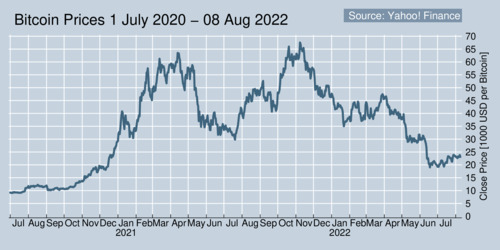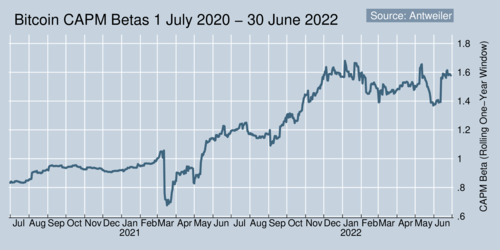Bitcoins are having a bad streak, even worse than the stock market. The price of bitcoins took off in a major way during the early stages of the pandemic and moved from about $10,000 to over $60,000 by April 2021, fell back to $30,000 in July 2021, took flight again in November 2021, and now has crashed back to under $30,000. Calling it a roller coaster is probably appropriate.

click on image for high-resolution PDF version
No currency is as erratic as Bitcoins. The continued use of the term "cryptocurrency" is utterly misguided. It is not a currency because it lacks the functionality of a currency. In particular, it is simply no reliable store of value, and even as a medium of exchange it is of questionable practical value. Its use is not even cheap. Bitcoins and its cousins are crypto-assets. Their value is determined by supply and demand, and thus its value is as fickle as the sentiment of investors. To make matters worse, bitcoins are also an environmental menace, and they are increasingly becoming a social menace too. Investors who have been flocking to cryptoassets in the hope of making fast riches tend to be young and male and highly risk-seeking. But often these investors can ill afford losses and overexpose themselves to financial risk. Rather than allowing the Wild West of cryptoassets to continue, regulators should take a closer look at the repercussions. Cryptoassets are no different than other speculative investments and should not be awarded any preferential treatment. In particular, politicians should referain from pitching and hyping crypto.
How can economists tell that Bitcoins behave like any other asset? Simple: we use the Capital Asset Pricing Model (CAPM) to look at how a particular stock or asset compares to the overall market. We estimate two coefficients, known as "alpha" and "beta", that capture the intercept and slope of a regression of the daily return of the asset against the daily market return, net of any risk-free return. More sophisticated models introduce additional factors, such as the Fama-French Three-Factor Model and its many extensions. Below are the results of the CAPM for the USD Bitcoin price and the U.S. Market (data). The chart below shows the "beta" estimated from rolling one-year CAPM regressions.

click on image for high-resolution PDF version
The chart shows that by early-2021, Bitcoins move already well with the market overall: the "beta" was approaching 1. By mid-2021, Bitcoins started to move in excess of the market, amplifying market swings. By January 2022 the "beta" has reached 1.6. My Fama-French data ends at the end of March, but by now it is clear that Bitcoin is increasingly acting like just another tech stock, as David Yaffe-Bellany reported in the New York Times a few days ago. This phenomenon has been report widely, for examply also by Tobias Adrian, Taray Iyer, and Mahvash Qureshi in the IMFBlog Crypto Prices Move More in Sync With Stocks, Posing New Risks. It is thought that market participation by institutional investors has been driving this increase in market correlation. Ultimately, bitcoins are just another risky asset. Caveat emptor — buyer beware!
Further readings and information sources:
- Yukun Liu and Aleh Tsyviski: Risks and Returns of Cryptocurrency, The Review of Financial Studies 34(6), June 2021, pp. 2689-2727.
Updated on Tuesday, August 9, 2022
![[Sauder School of Business]](logo-ubc-sauder-2016.png)
![[The University of British Columbia]](logo-ubc-2016.png)